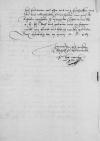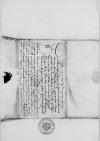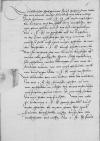 GStA PK, HBA, C1 No 822, 3v
GStA PK, HBA, C1 No 822, 3v
Dem durchlauchtigen, hochgebornen fursten und herren, hern ⌊Albrechten⌋, von Gots gnaden marggraffen zu ⌊Brandenburg⌋, / in ⌊Preussen⌋, zu ⌊Stetin⌋, ⌊Pommern⌋, der ⌊Cassuben⌋ und ⌊Wenden⌋ hertzogk, burggraff zu ⌊Normberg⌋ und furst zu ⌊Rugenn⌋, unserm hochgunstigen, lieben hern und freunde
 GStA PK, HBA, C1 No 822, 1r
GStA PK, HBA, C1 No 822, 1r
Durchlauchter, hochgeborner furst, hochgunstiger, lieber her und freundt. / Unsere freuntliche und vleiswillige dinste zuvoran. /
E(wer) F(urstlichen) D(urchlauch)t uff unser negst ⌊⌋ ⌊⌋ / und den zedell dorin vorschlossen / hab wir gerne gelesen, / und ist uns fast wolgefallenn, / das E(wer) F(urstliche) D(urchlauch)t ire geschickte uff die ⌊tagefart in der Cron⌋ abzufertigen hat vorgenommen, / die welche so stille nicht wirt mugen gehalten. / Es werden derhalben E(wer) F(urstlichen) D(urchlauch)t bericht uberkommen. / Bei uns ists ungewis, / das ane beiwesen ⌊koniglicher m(aieste)t⌋, unsers aller gnedigisten herren, / solche ⌊tagleistung⌋ solt gehaltenn werden, / derwegen so wir was bestendiges erfaren, / wie wir negst geschrieben, / wolle wir durch eigen boten E(wer) F(urstlichen) D(urchlauch)t nicht vorhalten, / und bedancken uns mit sonderm vleis des erbietens, / das uns E(wer) F(urstliche) D(urchlauch)t zuwissen gethan, / ab wir iren geschickten an solchen tag / etwas unser sachen mitzugeben gesint weren, / do wir nicht sonders dismal haben auszurichten. /
Was wir aber zu forderung E(wer) F(urstlichen) D(urchlauch)t grentz handell / durch unser schreiben / bei unsern guten hern unnd freunden fortzustellen wusten, / dorzu sein wir unbeschwert / und willig, / dan E(wer) F(urstliche) D(urchlauch)t freunt GStA PK, HBA, C1 No 822, 1vlich zudienen, / vil ehre und nutz zuschaffen, / und der uns allenthalben zuvorhalten, / wie auch der achtbar, wolgelert h(er) magister ⌊Johan Lomuller⌋, E(wer) F(urstlichen) D(urchlauch)t rath und getreuer, wirt anzeigenn, / wolle wir bereitt und begirig werden gefunden. /
GStA PK, HBA, C1 No 822, 1vlich zudienen, / vil ehre und nutz zuschaffen, / und der uns allenthalben zuvorhalten, / wie auch der achtbar, wolgelert h(er) magister ⌊Johan Lomuller⌋, E(wer) F(urstlichen) D(urchlauch)t rath und getreuer, wirt anzeigenn, / wolle wir bereitt und begirig werden gefunden. /
Dat(um) ⌊Heilsberg⌋, den VII Marcii M D XLII. /
⌊Ioannes⌋, von Gots gnaden bischoff zu ⌊Ermelandt⌋ /
Io(an)nes ep(iscopu)s Varmen(sis) etc. ma(n)u p(ro)pria s(ub)s(cripsi)t
Postscript:
 GStA PK, HBA, C1 No 822, 2r
GStA PK, HBA, C1 No 822, 2r
Wir haben aus E(wer) F(urstlichen) D(urchlauch)t beigelegtem zedell eingenommen, das die uff dem vorharret, / notigzusein, / ein zusammen kommen mit E(wer) F(urstlichen) D(urchlauch)t und unsern / neben unsers wirdigen capittels / ⌊rethen⌋ / von wegen beiderseits zufuhr und kauffmans wahr zuhalten. / Dieweil wir aber in unser ersten in dis unser ⌊bischtumb⌋ ankunft / von E(wer) F(urstlichen) D(urchlauch)t ersucht, / ab wir in unsers negsten seligen vorfarn vortrag und bewilligung, / zu ⌊Bartenstein⌋ aufgericht, / wolten bleiben, / hab wir von uns lassen wissen, / das wir in, / wie er von uns gefunden, / wolten lassen in seinen wirden / und doruber halten, / wie wir auch bisher gethan. / Und sehens nach vor das beste an, / weil wir solchen vortrag uff E(wer) F(urstlichen) D(urchlauch)t ersuchen nach unsers seligen ⌊vorfarn⌋ tode volkomilch angenommen, / und beiderseits ⌊lands⌋ zum besten eintrechtiglich gemacht zusein erkennen, / das dorin kein vorenderung, / ader doruber was neues wurd vorgenommen. / Solchs ist auch unsers w(irdigen) ⌊capittels⌋ beger und bitt etc.
Was weiter des gewalts halben aus dem balgischenn ampt uff dem unsern gescheen, / und was sonst im zedell erhalten / ist betreffend, / hab wir dem gemelten h(ern) magistro ⌊Johan Lomuller⌋ an E(wer) F(urstliche) D(urchlauch)t zubringen mitgegeben, / die wir freuntlich bittenn im hirinne zugleubenn / und gnediglich zuhorenn. /
 GStA PK, HBA, C1 No 822, 1vlich zudienen, / vil ehre und nutz zuschaffen, / und der uns allenthalben zuvorhalten, / wie auch der achtbar, wolgelert h(er) magister
GStA PK, HBA, C1 No 822, 1vlich zudienen, / vil ehre und nutz zuschaffen, / und der uns allenthalben zuvorhalten, / wie auch der achtbar, wolgelert h(er) magister 


